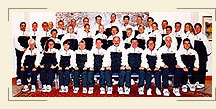|
The Silent Games
In the summer of 1924, about two weeks after the end of the eighth Olympic Games, which were held in great splendour in Paris, another international  sports meeting, less "splendid", took place in the same city. 145 athletes from 9 countries participated in it, a small number compared to the approximately 3,100 athletes from 44 countries who took part in the Olympics. These games were the first "International Silent Games", an organization modelled on the Olympic Games. The participant athletes came from 6 countries that already had a sports federation (France, Belgium, Great Britain, Czechoslovakia, the Netherlands, and Poland), as well as from three more European countries (Hungary, Italy, and Romania). The advocate of this movement was the French Eugene Rubens-Alcais, who right after the success of the games pioneered the creation of an international sports federation (Comite International des Sports des Sourds - CISS). sports meeting, less "splendid", took place in the same city. 145 athletes from 9 countries participated in it, a small number compared to the approximately 3,100 athletes from 44 countries who took part in the Olympics. These games were the first "International Silent Games", an organization modelled on the Olympic Games. The participant athletes came from 6 countries that already had a sports federation (France, Belgium, Great Britain, Czechoslovakia, the Netherlands, and Poland), as well as from three more European countries (Hungary, Italy, and Romania). The advocate of this movement was the French Eugene Rubens-Alcais, who right after the success of the games pioneered the creation of an international sports federation (Comite International des Sports des Sourds - CISS).
Four years later, again in imitation of the Olympics, Amsterdam hosted the second organization of the "International Silent Games" with 210 athletes from ten countries. The two following organizations were distinct from the Olympic Games, as to both the place and the time. More precisely, the third games were held in 1931 in Nuremberg and the fourth in 1935 in London. The following organization took place in Stockholm with the participation of almost 270 athletes from 13 countries. It was then that the flag of the Federation made its first appearance. The outbreak of World War II led to the cancellation of all sports organizations. Therefore, the sixth international games of deaf people were held in 1949 in Copenhagen, a year after the Olympics. Ever since, the games have been held every four years, the year after the Olympic Games. In general, there is a gradual increase of the entries, both of athletes and nations. More precisely:
- 1953: Brussels, 524 athletes from 16 nations
- 1957: Milan, 625 athletes, 25 nations
- 1961: Helsinki, 595 athletes, 24 nations
- 1965: Washington, 697 athletes, 27 nations
- 1969: Belgrade, 1183 athletes, 33 nations
- 1973: Malmo, 1061 athletes, 32 nations
- 1977: Bucharest, 1468 athletes, 37 nations
- 1981: Cologne, 1663 athletes, 32 nations
- 1985: Los Angeles, 1648 athletes, 29 nations
- 1989: Christchurch, 1663 athletes, 32 nations
- 1993: Sofia, 1900 athletes, 51 nations
- 1997: Copenhagen, 2078 athletes, 57 nations
- 2001: Rome, 4000 athletes, 80 nations
In the first games of 1924, five sports were carried out (athletics, aquatics, cycling, football, shooting). Today, the programme of the games includes 15 sports. Since 1949, winter games have been held every four years, which since 1955 have taken place in the interval between two summer games.
The 1950s were of a particular importance for the international sports federation, the CISS, seeing that in 1951, after two and a half decades of coldness, began the first official contacts with the IOC. Four years later, in 1955, the IOC recognized the CISS as an international federation having Olympic status. This, of course, engendered the obligation of the CISS to abandon the use of the IOC symbols and remove the word "Olympic" from the programme of its own games. The next milestone was the date of the 19th CISS session, which was held in 1967. Then, the accedence of new countries to the CISS led to the decision to change its name from "International Games" to "World Games". From the mid-1980s the CISS initiated dialogue with other international federations of athletes with special problems, which moved towards the organization of the Paralympic Games. However, due to the persistence of the CISS to maintain the "Silent Games", the negotiations reached a deadlock, despite the mediatory effort of the IOC, which continued to recognize and collaborate both with the CISS and the International Paralympic Committee - IPC.
Today, more than 80 countries have national federations organically associated with the CISS.
|